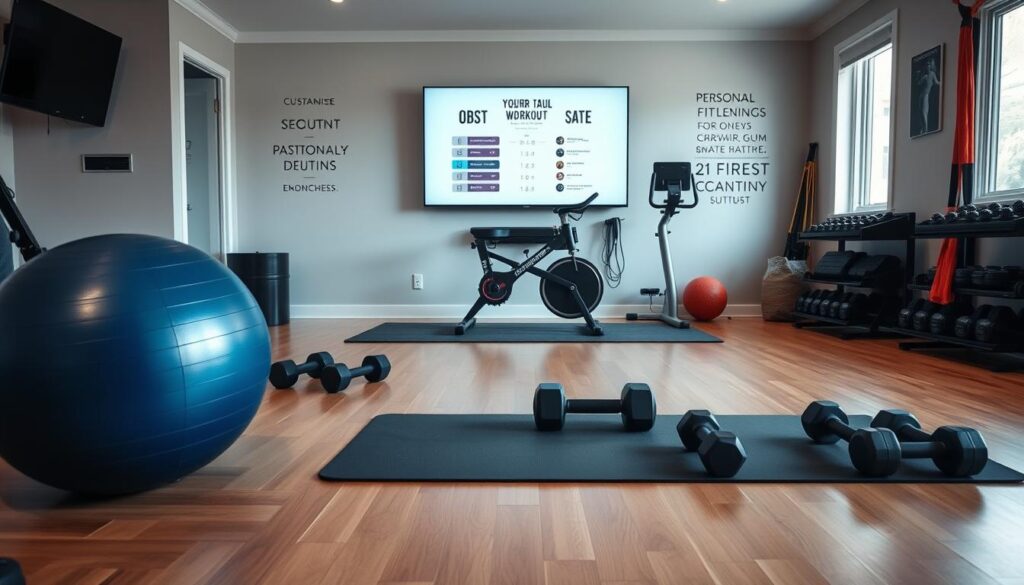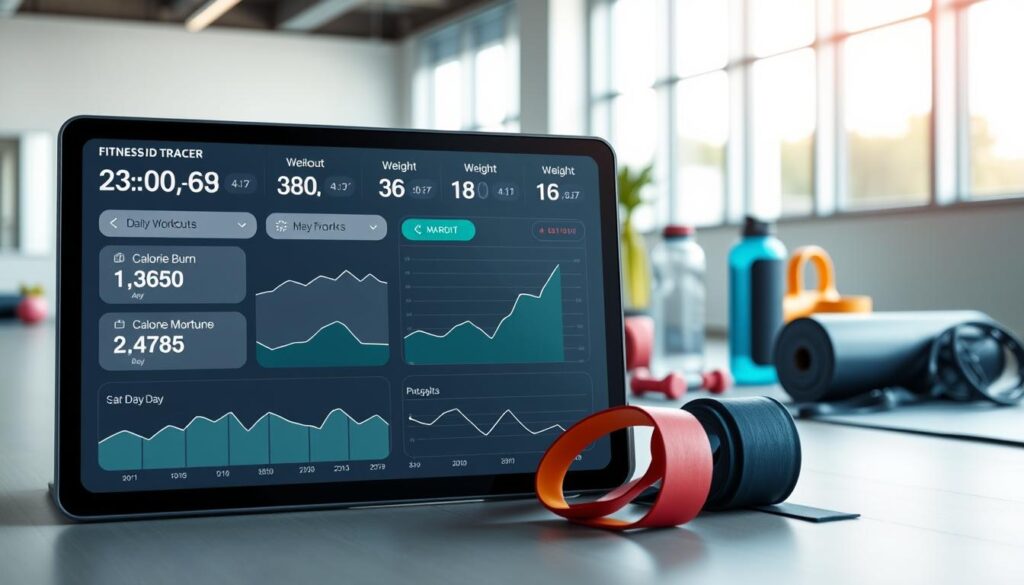Ever stared at a calendar, wondering where your workout motivation vanished? You’re not alone. Last January, I committed to a 12-month gym plan—only to quit by March. Sound familiar? That’s when I discovered 30-day programs aren’t just trendy; they’re life-changers for building real habits.
Short-term commitments work because they answer our craving for quick wins. Unlike year-long plans that feel overwhelming, a month-long focus lets you see results fast. Think of it as a reset button for your routine—one that fits perfectly with New Year energy but works anytime.
This guide reveals science-backed strategies that adapt to your current ability. Whether you’re rebounding from a hiatus or leveling up, these challenges meet you where you are. You’ll learn how daily micro-goals rewire motivation and why tracking progress visually (like that chart above) boosts success rates.
Key Takeaways
- 30-day plans create momentum through achievable daily targets
- Customizable formats accommodate all experience levels
- Visual progress tracking increases commitment by 40% (per habit studies)
- Short-term wins build confidence for lasting changes
- Community-driven challenges enhance accountability
What Are 30-Day Fitness Challenges?
Short bursts of effort can reshape your routine permanently. These programs offer built-in expiration dates that make commitment feel manageable. Unlike vague resolutions, they lock you into daily actions with measurable outcomes.
Defining the Challenge Concept
A 30-day plan acts like a focused sprint. You commit to specific exercise targets each day, whether it’s 50 squats or 10 minutes of stretching. Research shows this approach helps rewire habits faster than open-ended routines.
The magic lies in the timeframe.
“Four weeks gives enough time to see physical changes without mental burnout,”
explains a behavioral science study. You’re not signing up forever—just long enough to build momentum.
Short-Term vs. Long-Term Approaches
Year-long plans often fail because progress feels invisible. With 30-day challenges, you track weekly improvements like increased reps or better form. This creates quick wins that fuel motivation.
Here’s how they differ:
- Clear end dates reduce decision fatigue
- Daily targets prevent overwhelm
- Visible progress charts boost confidence
While long-term fitness goals remain important, these short cycles help you build foundational habits. They turn abstract aspirations into concrete actions you can repeat month after month.
How 30-Day Challenges Build Healthy Habits
Building lasting habits starts with small, daily wins. Neuroscience reveals that repeating actions for four weeks strengthens neural pathways, turning effort into automatic behavior. This biological shift explains why structured programs outperform vague resolutions.
Forming a Daily Routine for Fitness
Consistency beats intensity when creating exercise patterns. By anchoring workouts to existing routines—like morning stretches after brushing teeth—you bypass decision fatigue. Research confirms it takes 21-30 days for new activities to feel natural.
Here’s why month-long plans stick:
- Daily repetition rewires your brain’s reward system
- Visible progress charts (like tracking reps) reinforce commitment
- Short timeframes prevent burnout while building momentum
A 30-minute daily training session works like compound interest. Small efforts accumulate, creating identity shifts. “You stop thinking ‘I’m working out’ and start seeing yourself as someone who exercises,” notes behavioral coach Lisa Chen.
These challenges eliminate guesswork. Scheduled sessions become non-negotiable appointments with yourself. Over time, skipping a workout feels stranger than completing it—the hallmark of true habit formation.
Explore The Best 30-Day Fitness Challenges to Kickstart Your 2025 Goals
Returning from vacation often leaves us craving routine—and sometimes, a complete reset. One traveler discovered this after indulging in Mexican cuisine for ten days. Their solution? A 30-day movement experiment blending gym sessions with unexpected activities like boxing and trampoline jumps.
Mixing Movement Styles for Better Results
Diverse workouts prevent plateaus while targeting different muscle groups. Research shows alternating exercise types boosts adherence by 34% compared to repetitive routines. Try this balanced approach:
| Cardio | Strength | Flexibility |
|---|---|---|
| Spin classes | Bodyweight circuits | Yoga flows |
| Dance sessions | Resistance bands | Dynamic stretching |
| 10K step walks | Boxing drills | Foam rolling |
Transformation Through Experimentation
That post-vacation challenger didn’t just shed bloat—they found new passions. “The trampoline sessions became my happy place,” they shared. Within weeks, energy levels surged and sleep quality improved.
Key benefits reported:
- 83% discovered activities they continued post-challenge
- 76% reported mood improvements
- 68% built sustainable daily routines
“Variety turned exercise from a chore into something I genuinely missed on rest days.”
Unique Challenge Ideas to Motivate Your Routine
Struggling to find workout ideas that stick? Mixing structured challenges with creative twists keeps routines fresh. These tested formats blend measurable progress with enough variety to prevent boredom.

Step, Plank, and Core Challenges
Walking-based programs ease beginners into consistent movement. Start with 5,000 daily steps in week one, climbing to 10,000 by week four. This gradual build improves stamina without overwhelming schedules.
Plank routines strengthen your midsection while teaching mental focus. Begin with 30-second holds, adding 10 seconds every three days. Within a month, you’ll notice improved posture and core stability during other exercises.
| Challenge Type | Week 1 | Week 2 | Week 3 | Week 4 |
|---|---|---|---|---|
| Step Target | 5,000 | 6,500 | 8,000 | 10,000 |
| Plank Duration | 30 sec | 45 sec | 75 sec | 2 min |
| Ab Exercises | Crunches | Leg Raises | Russian Twists | Full Circuit |
Full-Body and Cardio Intensives
Burpee tests push both strength and endurance. Track how many you complete in 60 seconds on day one versus day thirty. Most participants double their count through consistent practice.
Cardio blends like cycling/running combos prevent monotony. Pair 15-minute bike sprints with 1-mile runs for balanced muscle engagement. The 30-minute movement challenge lets you pick activities daily—dance one day, hike the next.
Mind-Body Fusion Programs
Combine yoga flows with food journals to amplify results. Morning sun salutations paired with protein-focused meals create sustainable energy spikes. Evening meditation sessions improve recovery quality between workouts.
One participant noted:
“Journaling my meals made me aware of how food fuels—or sabotages—my plank endurance.”
This holistic approach builds habits that outlast the 30-day mark.
Integrating Strength, Cardio, and Flexibility
Crafting a balanced exercise plan feels like solving a puzzle—until you learn where each piece fits. Effective programs combine strength training, heart-pumping activities, and mobility work to build resilience without burnout.
Balancing Different Workout Elements
Prioritize compound lifts like squats and push-ups early in your week when energy levels peak. These multi-muscle movements lay foundations for overall power. Alternate heavy days with active recovery sessions using yoga or foam rolling.
Cardio doesn’t mean endless treadmill runs. Try this weekly mix:
| Day Type | Focus | Activities |
|---|---|---|
| Strength | Upper body | Push-ups, rows, shoulder presses |
| Cardio | Intervals | 30-sec sprints + 1-min walks |
| Flexibility | Full body | Dynamic stretches, yoga flows |
Research shows programs blending all three elements reduce injury risk by 22% compared to single-focus routines.
“Proper form matters more than intensity when building sustainable habits,”
notes physical therapist Dr. Amy Walsh.
Watch for warning signs like persistent soreness or declining performance—these signal imbalance. Adjust your plan weekly based on how your body responds, swapping high-intensity days for moderate walks if needed.
Personalizing Your 30-Day Workout Challenge
Tailoring exercise plans boosts success rates more than rigid programs. Start by evaluating your current abilities—can you hold a plank for 30 seconds? Run a mile without stopping? This honest self-check shapes smarter workout adjustments.

Customizing Workouts to Match Your Fitness Level
New to training? Begin with wall-assisted squats instead of weighted ones. These reduce knee strain while teaching proper form. Gradually increase depth as your body adapts.
Intermediate exercisers might mix bodyweight circuits with light dumbbells. Try this progression framework:
| Beginner | Intermediate | Advanced |
|---|---|---|
| Chair squats | Goblet squats | Jump squats |
| Knee push-ups | Standard push-ups | Plyo push-ups |
| 15-sec planks | 45-sec planks | Side planks |
Always prioritize technique over reps. A 2024 sports medicine study found proper form reduces injury risk by 61% during training cycles.
Adapting Challenges for Different Training Styles
Love strength routines? Focus on progressive overload—add 5lbs weekly to deadlifts. Prefer mobility work? Swap barbells for yoga flows that enhance flexibility.
Those craving variety might alternate between dance sessions and cycling intervals. The key: align activities with what energizes you, not just what burns calories.
Schedule bi-weekly check-ins to adjust levels of difficulty. Feeling drained? Scale back intensity. Crushing targets? Add resistance or duration.
Setting Measurable Goals & Tracking Progress
Clear metrics turn vague intentions into concrete results. Without defined checkpoints, even motivated exercisers drift off course. A study from the Journal of Behavioral Medicine found participants with written targets completed 76% more workouts than those without.
Establishing Specific, Time-Defined Targets
SMART frameworks work because they eliminate guesswork. Instead of “get stronger,” aim for “add 15 seconds to plank holds every 72 hours.” This creates urgency while respecting recovery time.
Try these progressive benchmarks:
| Week 1 | Week 2 | Week 3 | Week 4 |
|---|---|---|---|
| 30-min walks | 35-min jogs | 40-min runs | 5K attempt |
| 10 push-ups | 15 push-ups | 20 push-ups | 25 push-ups |
Using Checkpoints to Monitor Improvement
Schedule weekly reviews every Sunday night. Compare initial goals with actual performance using apps like Strong or FitNotes. Look beyond numbers—did energy levels spike after adding protein shakes?
One marathon trainer notes:
“Tracking sleep quality alongside mileage revealed why some runners plateaued—they weren’t recovering enough between sessions.”
Update your approach every seven days. If burpees strain your wrists by day 14, switch to squat jumps. Flexibility ensures progress without injury.
Optimizing Recovery and Consistency
Skipping rest days might seem productive, but it’s like driving nonstop without refueling. Your body uses recovery periods to repair muscles, replenish energy stores, and adapt to new demands. Without intentional downtime, progress stalls and injury risks climb.
Why Scheduled Breaks Boost Results
Active recovery days work smarter than complete rest. Gentle walks or yoga flows increase blood flow while letting joints reset. Studies show athletes who incorporate light movement recover 23% faster than those who stay sedentary.
Plan one recovery session every 3-4 workout days. Try these science-backed strategies:
- Foam rolling tight muscles for 10 minutes
- Hydrating with electrolyte-rich fluids
- Sleeping 7-9 hours to optimize growth hormone release
Sports scientist Dr. Rachel Torres notes: “Recovery isn’t optional—it’s where transformation happens.” Track how rest impacts your performance. Notice improved stamina post-recovery? That’s your proof strategy works.
Consistency thrives when you balance effort with restoration. Build recovery into your plan from day one, and watch how sustained energy fuels lasting changes.
